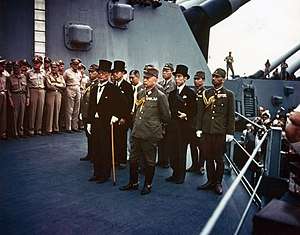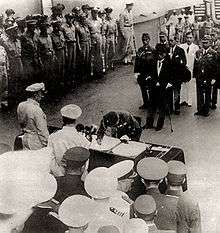Yoshijirō Umezu
Yoshijirō Umezu (梅津 美治郎, Umezu Yoshijirō) (January 4, 1882 – January 8, 1949) was a Japanese general in World War II and Chief of the Army General Staff during the final years of the conflict. He was convicted of war crimes and sentenced to life imprisonment.
Yoshijirō Umezu | |
|---|---|
梅津美治郎 | |
.jpg) | |
| Chief of the Imperial Japanese Army General Staff | |
| In office 18 July 1944 – September 1945 | |
| Monarch | Emperor Hirohito |
| Preceded by | Hideki Tojo |
| Succeeded by | Position abolished. |
| 17th Governors-General of the Kwantung Leased Territory | |
| In office 7 September 1939 – 18 July 1944 | |
| Monarch | Emperor Hirohito |
| Preceded by | Kenkichi Ueda |
| Succeeded by | Otozō Yamada |
| Personal details | |
| Born | January 4, 1882 Nakatsu, Ōita Prefecture, Japan |
| Died | January 8, 1949 (aged 67) Tokyo, Japan |
| Signature | |
| Military service | |
| Allegiance | Empire of Japan |
| Branch/service | |
| Years of service | 1903–1945 |
| Rank | General |
| Commands | Japanese China Garrison Army, IJA 2nd Division, Japanese First Army, Kwangtung Army, Imperial Japanese Army General Staff |
| Battles/wars | |
Biography
Early career
Umezu was born in Nakatsu, Ōita, Japan, where his family ran a bookstore since the 18th century. During his years at the Seisei High School in Kumamoto, he decided to pursue a military career. He graduated from the 15th class of the Imperial Japanese Army Academy on November 30, 1903 and was commissioned a second lieutenant in the infantry the following February 12, 1904. Promoted to lieutenant on June 30, 1905, he entered the 23rd class of the Army Staff College, graduating first in 1911. Following his promotion to captain on March 25, 1912, he was sent to Europe for further studies in Germany and Denmark. While in Denmark, he was also a military observer from Japan, during the course of World War I, and was promoted to major on June 1, 1918. From 1919 to 1921, he was appointed as a military attaché to Switzerland.[1]
Umezu was promoted to lieutenant colonel on February 8, 1922, and to colonel on December 15, 1925. During the 1920s, he was a member of the Tōseiha, led by General Kazushige Ugaki along with Gen Sugiyama, Koiso Kuniaki, Tetsuzan Nagata and Hideki Tōjō. They represented a politically moderate line within the armed forces, in opposition to the radical Kōdōha movement, guided by Sadao Araki. Umezu served as an instructor at the Army Staff College from 1923–1924, and was commander of the IJA 3rd Infantry Regiment from 1924–1926.
Umezu was promoted to major general in August 1930 and commander of the IJA 1st Infantry Brigade. He worked at the General Staff from August 1933, and was sent as a military attaché to Switzerland from November 1933. After his return to Japan in March 1934, he was appointed commander of the Japanese China Garrison Army and in November repelled a large-scale Chinese incursion into Rehe Province. In June 1935 he signed the He–Umezu Agreement. which was an attempt to defuse tensions between the Republic of China and Japan, and which gave Japan control over ten province of Hebei. Umezu was promoted to lieutenant general in August. In August 1935, he became commander of the Sendai-based IJA 2nd Division.[2]He strongly opposed the February 26 incident attempted coup-de-etat in 1936. Umezu was appointed Vice Minister of War from March 1936 and working under Army Minister Terauchi Hisaichi, purged many of the radical kōdōha members from the Army ranks.
World War II

Umezu returned to China in May 1938 as commander-in-chief of the IJA 1st Army. By this time, the IJA 1st Army had completed its combat operations, and was serving as a garrison force in Japanese-occupied northern China. From September 1939 he was commander-in-chief of the Kwangtung Army, which was likewise acting as a garrison force in Manchukuo. He was promoted to full general on August 1, 1940.[3]
In July 1944, Umezu was appointed as the final Chief of the Imperial Japanese Army General Staff, and a member of the Supreme War Council, following the resignation of Hideko Tojo. Along with Army Minister Korechika Anami and Chief of Imperial Japanese Navy General Staff, Soemu Toyoda, Umezu opposed surrender in August 1945; he believed that the military should fight on, forcing the Allies to sustain such heavy losses in an invasion of Japan, that Japan could negotiate for peace under better terms. He was aware of the planned coup d'état by junior officers opposed to the surrender, but did nothing to either aid or hinder it.[4] He was personally ordered by Emperor Hirohito to sign the instrument of surrender on behalf of the armed forces on September 2, 1945 and was thus the Army's senior representative during the surrender ceremonies on the battleship USS Missouri, officially ending World War II.[5] He entered the reserves on November 30.
After the war, he was arrested by the SCAP authorities and tried as a war criminal at the International Military Tribunal for the Far East in Tokyo. He was found guilty of Counts 1, 27, 29, 31 and 32 of waging a war of aggression and sentenced to life imprisonment on November 12, 1948.[6]
While in Sugamo Prison, he became a convert to Christianity. Umezu died from rectal cancer in 1949 while still incarcerated.


Decorations
- 1906 –

- 1906 –

- 1913 –
_5Class_BAR.svg.png)
- 1915 –

- 1922 –
_3Class_BAR.svg.png)
- 1933 –
_2Class_BAR.svg.png)
- 1936 –
_1Class_BAR.svg.png)
- 1939 –

- 1940 –

References
- Butow, Robert J. C. (1954). Japan's Decision to Surrender. Stanford University Press. ASIN: B000VFCC14.
- Dupuy, Trevor N. (1992). Encyclopedia of Military Biography. I B Tauris & Co Ltd. ISBN 1-85043-569-3.
- Frank, Richard B. (1999). Downfall: the End of the Imperial Japanese Empire. Penguin, non-classics. ISBN 0-14-100146-1.
- Fuller, Richard (1992). Shokan: Hirohito's Samurai. London: Arms and Armor. ISBN 1-85409-151-4.
- Hayashi, Saburo; Cox, Alvin D (1959). Kogun: The Japanese Army in the Pacific War. Quantico, Virginia: The Marine Corps Association.
- Kase, Toshikazu (1950). Journey to the Missouri.
- Maga, Timothy P. (2001). Judgment at Tokyo: The Japanese War Crimes Trials. University Press of Kentucky. ISBN 0-8131-2177-9.
Notes
| Wikimedia Commons has media related to Yoshijiro Umezu. |
| Wikiquote has quotations related to: Yoshijirō Umezu |
- Dupuy, Encyclopedia of Military Biography
- Ammenthorp, the Generals of World War II
- Budge, Pacific War Online Encyclopedia
- Butow, Japan's Decision to Surrender
- Shokan, Hirohito's Samurai
- Maga, Judgement at Tokyo
- http://dl.ndl.go.jp/info:ndljp/pid/10273436?__lang=en
- 『官報』第251号「叙任及辞令」June 2, 1913
External links
- USS Missouri
- Ammenthorp, Steen. "Umezu, Yoshijiro". The Generals of World War II.
- Budge, Kent. "Umezu, Yoshijiro". Pacific War Online Encyclopedia.
- Clancy, Patrick. "HyperWar:IMTFE Judgement". HyperWar Foundation.
| Government offices | ||
|---|---|---|
| Preceded by Kenkichi Ueda |
Governor-General of Kwantung 1939–1944 |
Succeeded by Otozō Yamada |
| Military offices | ||
| Preceded by Kotaro Nakamura |
Commander, China Garrison Army Mar 1934 – Aug 1935 |
Succeeded by Hayao Tada |
| Preceded by Kiyoshi Katsuki |
Commander, IJA 1st Army May 1938 – Sept 1939 |
Succeeded by Yoshio Shinozuka |
| Preceded by Kenkichi Ueda |
Commander, Kwantung Army Sept 1939 – Jul 1944 |
Succeeded by Otozō Yamada |
| Preceded by Hideki Tōjō |
Chief of Imperial Japanese Army General Staff Jul 1944 – Sept 1945 |
Succeeded by none |